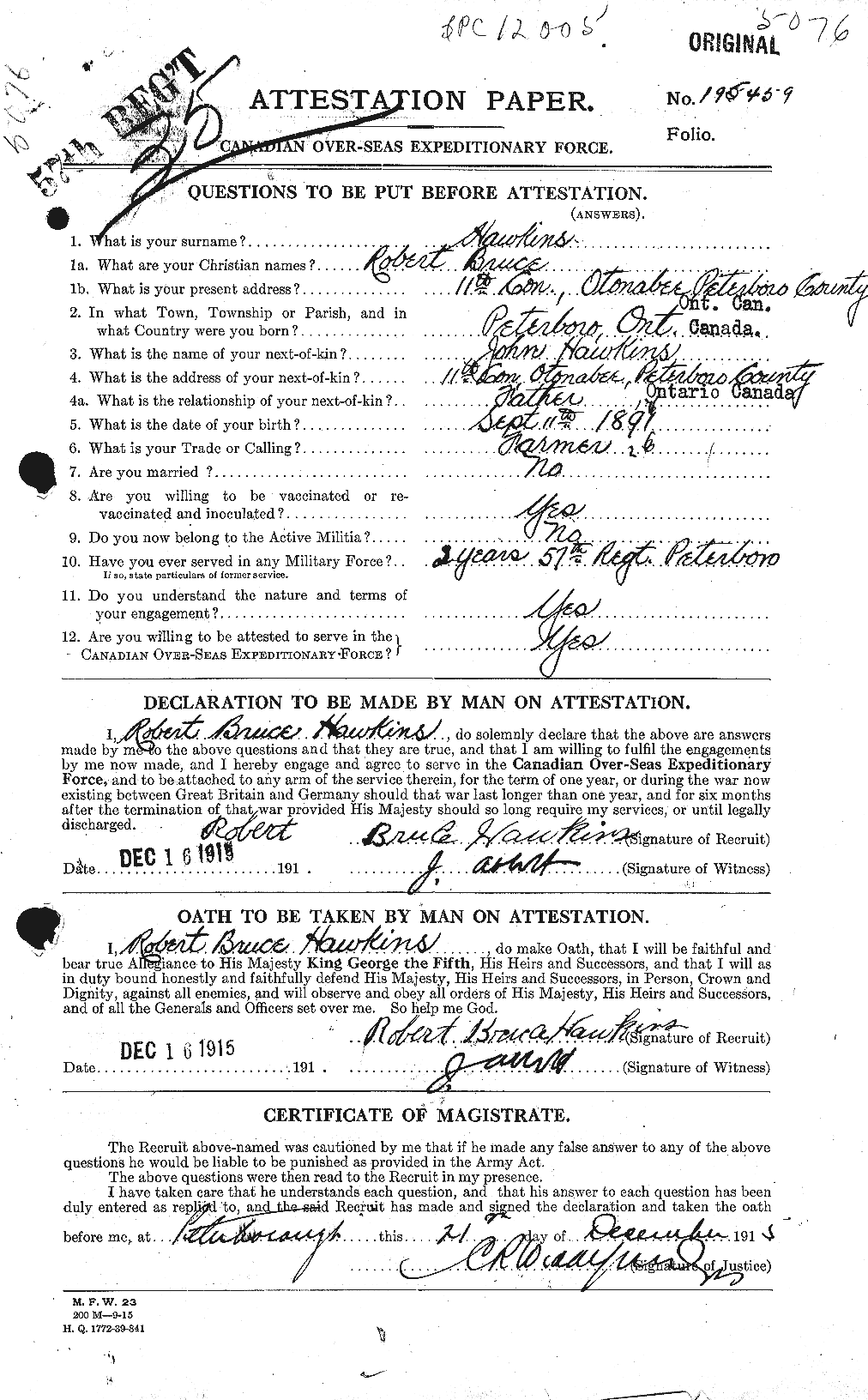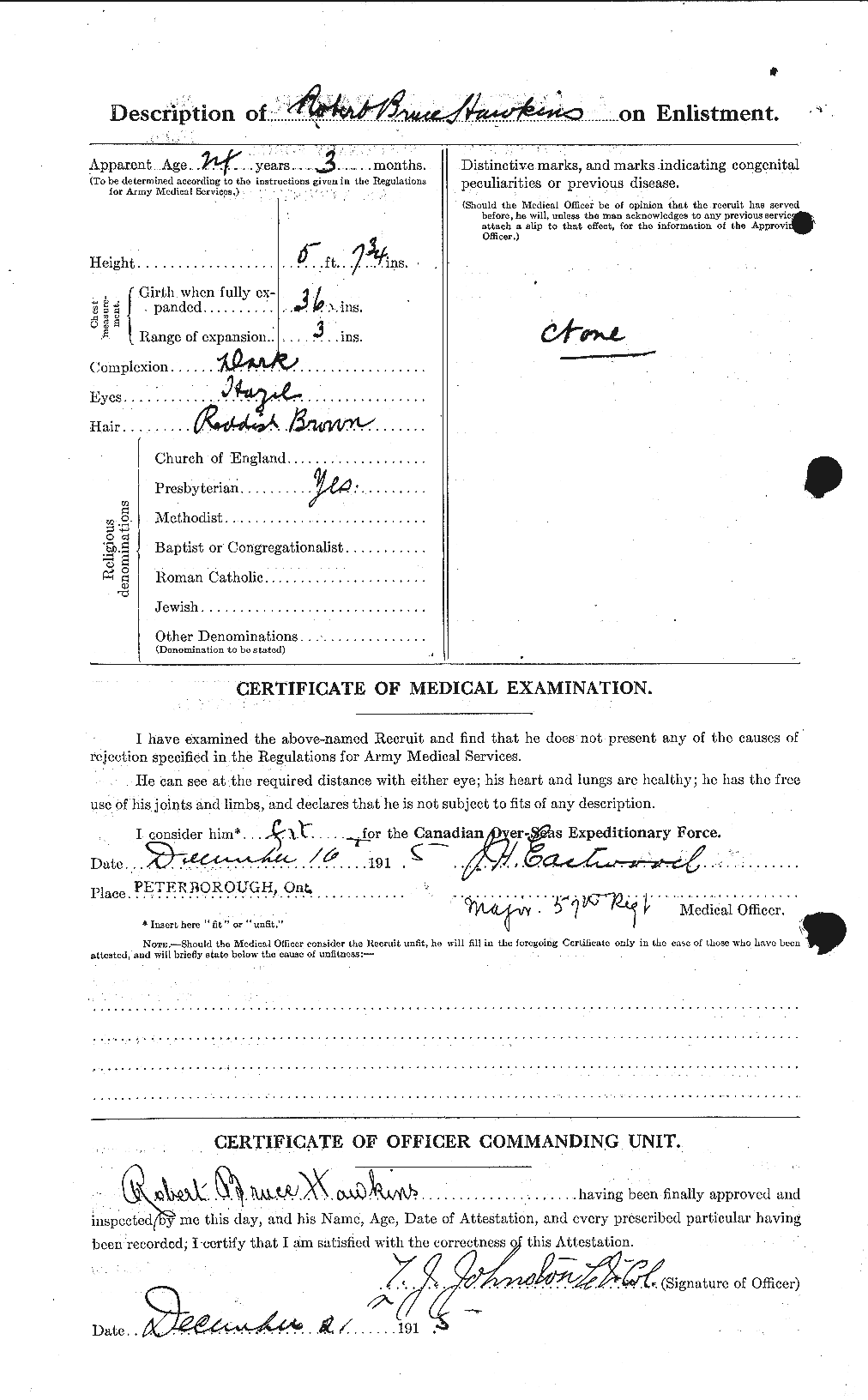
In Memory of
Pte. Robert Bruce Hawkins

Robert Bruce Hawkins was born in Peterborough, Ontario on September 11th 1891 to Harriet and James Hawkins. He was 24 years old at enlistment. He was described as having reddish-brown hair, hazel eyes, and dark complexion. His height was 5-foot 7-and-three-quarters tall. His religion was Presbyterian. He also reported having 2 years of previous military experience with the 57th Regiment in Peterborough. Pte. Hawkins worked as a farmer, and continued to live in Otonabee Peterborough County. After enlisting on December 16th 1915, he was cleared for service on December 21st 1915. The agreement when enlisting was, to serve for 1 year, or until the war was over plus an extra six months following. After training for months, Pte. Hawkins embarked from Halifax on July 15th, 1916, on the S.S. Empress of Britain. After a ten day trip, the ship arrived in Liverpool, England, on July 25th 1916. He was then transferred from the 93rd battalion, to the 19th battalion on the 15th of September 1916. Eventually, Pte. Hawkins was sent to the field on the 2nd of October 1916. A few months later, he was checked into the hospital and diagnosed with influenza early December of 1916 in France. He was then sent back out to the field within three days. Four months after returning to the field, Pte. Hawkins was killed in action April 9th 1917, while fighting in The Battle of Vimy Ridge. Counting from the day Pte. Hawkins arrived in England, to the day of this death, he served 258 days. Following his death, his belongings and earnings from the war were assigned to his widow, Mrs. Agnes Hawkins, and his mother Mrs. Harriet Hawkins, despite the fact his next-of-kin being his father on his attestation papers.





The attestation paper Robert Bruce Hawkins filled out at enlistment and his medical examination following.
(Click images to magnify)
(Click images to magnify)
Memorial

Robert Bruce Hawkins was killed in action April 9th, 1917, during The Battle of Vimy Ridge. He is now buried outside of Thelus, France, at the Nine Elms Military Cemetery. His grave reference is IV. C. 18. The cemetery is located approximately 1.5 kilometers south of Thelus on the Western side of the road. The cemetery is about 5 kilometers from the Canadian Vimy Memorial. Pte. Hawkins's name is displayed in the Memorial Chamber of Peace Tower on June 5th, on page 253.



Historical Fiction



*These are not the actual letters Robert Bruce Hawkins sent to his family and back. They are creative interpretations from research.
Letters can be clicked to magnify
The 19th Battalion
The 19th battalion continued to fight in the war, in major battles, including, Battle of the Somme, Passchendaele, and battle of Amiens. The 19th battalion was originally started in Toronto, Ontario, in 1914, but was then moved to England, and then France in 1915. Recorded in the battalion’s war diaries, it was not unusual to have about 3-5 men become sick per day, and they also managed to collect many German maps. In March of 1917, almost everyday is described as quiet, with occasional events such as shelling, trench mortars, and artillery action.

Canadian Nurses Serving Overseas
Over 2000 Canadian Nurses served overseas during the first World War. They wore a uniform of a blue nursing dress, and white veils, giving them the nickname, "bluebirds". All nurses were previously trained as nurses before serving in the war, and the typical age was 24. Most of the nurses were single, and had relatives serving as soldiers. Unlike the soldiers, there was never not enough nurses. When the war began, women rushed to enlist. Nurses were the first to see a wounded soldier and start immediate treatment. They then would help in surgeries, check up on the wounded, do daily tasks to help them recover, and track progress.
A total of 53 Canadian nurses died serving overseas. Some from disease, drowning, and others from the war brutality itself. Hospitals were occasionally attacked by air raids. The women who went overseas as nurses demonstrated exceptional courage through not only their work in the hospitals, but also through helping soldiers escape enemies when captured. Edith Cavell was recognized for this as she assisted about 200 soldiers escape from The Germans in Belgium. There is now a Nursing sisters memorial in Ottawa at the Parliament Buildings.
"Heritage Minutes: Nursing Sisters" on Youtube.
Video courtesy of Historica Canada on Youtube. This short 1:02 clip demonstrates some of the hard work, courage, and horrible results of war the Canadian Nurses experienced in The Great War